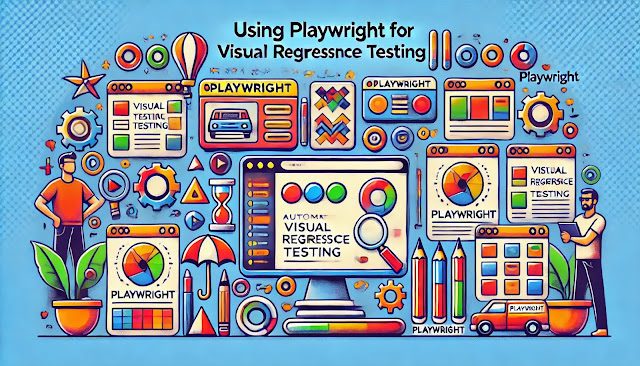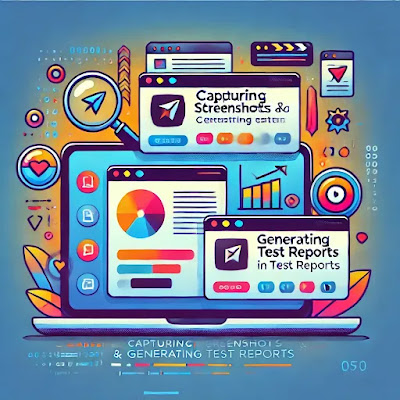Using Playwright for Visual Regression Testing
Using Playwright for Visual Regression Testing
Visual consistency is crucial for user experience and brand integrity in modern web applications. A small unintended change in your UI can disrupt the user experience and introduce bugs that might go unnoticed. This is where visual regression testing becomes essential. By comparing current screenshots of your application to a baseline, you can automatically detect unintended changes.
In this guide, we’ll explore how to use Playwright for visual regression testing, enabling you to automate the process of detecting visual changes in your web application, ensuring that your UI remains consistent across updates.
What is Visual Regression Testing?
Visual regression testing is a method of comparing two versions of a web application to detect visual changes. This involves capturing screenshots of web pages or components and comparing them to baseline images from previous builds. If any visual discrepancies are found, the test can flag them for further investigation.
Key reasons to use visual regression testing include:
- UI Consistency: Ensure that updates to your application don’t unintentionally affect the look and feel of your user interface.
- Cross-browser Compatibility: Test how your UI appears in different browsers, ensuring a consistent experience for all users.
- Automation: Automating visual regression tests allows for quick detection of bugs and saves time during the QA process.
Why Use Playwright for Visual Regression Testing?
Playwright is a powerful automation tool designed for modern web testing. It provides multi-browser support (Chromium, Firefox, WebKit) and can run tests across different devices and screen sizes. Playwright’s ability to capture screenshots and its integration with third-party visual comparison tools makes it ideal for visual regression testing.
Advantages of Using Playwright for Visual Testing
- Multi-browser Support: Playwright allows you to test across multiple browsers and platforms, ensuring cross-browser consistency.
- Automation: Automating visual tests with Playwright helps streamline your CI/CD process by quickly identifying visual bugs.
- Advanced Control: With Playwright, you can wait for specific UI elements or network states, ensuring that screenshots are captured at the right time.
Setting Up Playwright for Visual Regression Testing
To get started, you need to install Playwright and a visual comparison tool like pixelmatch, which is commonly used to compare images and detect differences.
Step 1: Install Playwright
First, install Playwright by running the following command:
npm install playwrightThen, install pixelmatch for image comparison:
npm install pixelmatchStep 2: Capturing Screenshots
Once you have Playwright set up, you can start capturing screenshots of your web application. Here’s a simple script to capture a screenshot of your web page:
const { chromium } = require('playwright');
const fs = require('fs');
const pixelmatch = require('pixelmatch');
const PNG = require('pngjs').PNG;
(async () => {
const browser = await chromium.launch();
const page = await browser.newPage();
// Navigate to your web app
await page.goto('https://your-web-app.com');
// Capture a screenshot
await page.screenshot({ path: 'current-screenshot.png' });
await browser.close();
})();
In this script:
- We launch a Chromium browser using Playwright.
- Navigate to the web application and capture a screenshot using
page.screenshot(). - The screenshot is saved as
current-screenshot.png.
Step 3: Comparing Screenshots
Next, you’ll need to compare the captured screenshot to a baseline image. We’ll use pixelmatch to perform the comparison. Here’s how you can do that:
const currentImage = PNG.sync.read(fs.readFileSync('current-screenshot.png'));
const baselineImage = PNG.sync.read(fs.readFileSync('baseline-screenshot.png'));
const { width, height } = currentImage;
const diff = new PNG({ width, height });
const numDiffPixels = pixelmatch(currentImage.data, baselineImage.data, diff.data, width, height, { threshold: 0.1 });
fs.writeFileSync('diff.png', PNG.sync.write(diff));
console.log(`Found ${numDiffPixels} pixel differences.`);
In this script:
- We load the current and baseline images using
PNG.sync.read(). - We use
pixelmatchto compare the two images and generate a diff image that highlights the differences. - If differences are found, a diff image is saved as
diff.png.
Handling Dynamic Content in Visual Testing
One challenge in visual regression testing is handling dynamic content, such as changing timestamps or user-generated content. Here are a few strategies to handle these cases:
1. Ignoring Certain Areas
For areas of the page that you know will change (e.g., timestamps), you can mask or ignore those areas during comparison:
const numDiffPixels = pixelmatch(currentImage.data, baselineImage.data, diff.data, width, height, {
threshold: 0.1,
diffMask: true // Ignores certain areas
});
2. Using a Fixed Dataset
When testing pages with dynamic data, it’s helpful to use a fixed dataset or mock API responses to ensure consistency between tests. Playwright allows you to intercept network requests and mock API responses:
await page.route('**/api/data', (route) => {
route.fulfill({
body: JSON.stringify({ name: 'Test User', timestamp: '2023-01-01' })
});
});
Integrating Visual Testing into Your CI/CD Pipeline
For continuous integration, it’s important to automate visual regression testing within your CI/CD pipeline. This ensures that every change to your application is tested for visual consistency. Popular CI/CD platforms like GitHub Actions, GitLab CI, and Jenkins can easily integrate with Playwright tests.
jobs:
test:
runs-on: ubuntu-latest
steps:
- name: Checkout code
uses: actions/checkout@v2
- name: Install dependencies
run: npm install
- name: Run visual regression tests
run: node visual-regression-test.js
This YAML configuration demonstrates how to set up a GitHub Actions workflow that runs visual regression tests on every push or pull request.
Best Practices for Visual Regression Testing
- Set a Consistent Environment: Ensure that visual tests run in the same environment every time, such as a headless browser with fixed screen sizes and device emulation.
- Use Baseline Images: Maintain a set of baseline images in version control, so you can compare new builds to previous versions.
- Automate in CI/CD: Automate visual tests as part of your continuous integration pipeline to catch UI regressions early.
- Handle Dynamic Content: Use strategies like mocking API responses or ignoring dynamic areas to avoid false positives in your tests.
Conclusion
Visual regression testing with Playwright allows you to automate the detection of unintended UI changes, ensuring that your web application remains visually consistent across updates. By capturing and comparing screenshots, you can catch bugs that may not be apparent in functional tests.
By following the steps outlined in this guide, you can seamlessly integrate Playwright into your testing workflow and ensure that your application’s visual integrity is maintained with each release.




Comments
Post a Comment